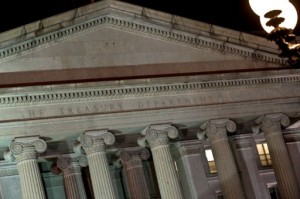Philippines to continue buying US treasuries
Debt paper still investment grade, highly liquid
By: Michelle V. RemoPhilippine Daily Inquirer

STILL INVESTMENT GRADE The facade of the US Treasury Department is seen on August 5, 2011, after Standard & Poor's cut the US credit rating from its top-flight triple-A one notch to AA+, and added a negative outlook to it. In reaction to the credit downgrade, the Bangko Sentral ng Pilipinas said a Double-A-plus rating was still investment grade and US treasuries remained to be instruments that the Philippines could invest in. AFP Photo/NICHOLAS KAMM
The Philippines will keep its holdings of US treasuries, which make up the bulk of the country’s foreign exchange reserves, even with the downgrading of the Triple-A credit rating of the United States.
In reaction to the credit downgrade by ratings firm Standard & Poor’s, the Bangko Sentral ng Pilipinas said a Double-A-plus rating was still investment grade and US treasuries remained to be instruments that the Philippines could invest in.
The BSP puts the bulk of its $69 billion worth of foreign exchange reserves in US treasuries. Under the investment guidelines of the BSP, the foreign exchange reserves should be invested only in investment grade and highly liquid instruments.
“For the BSP, US treasuries will continue to be within the allowable investible universe for our reserves even with the one-notch downgrade by S&P,” BSP Governor Amando Tetangco Jr. told reporters.
Tetangco said that even with the US credit downgrade, holding on to US treasuries remained prudent since these instruments were still the most liquid and since the value of European assets have been put at risk by the debt woes in the euro zone.
“Because the US market remains the most liquid and deepest and as Europe still faces uncertainty, the US market is not likely going to experience a huge selloff even with the one-notch downgrade. Many still see the US treasury market as a safe haven,” Tetangco said.
Still, the BSP chief said the country has over the years been diversifying its foreign exchange reserves. A small portion of the reserves is invested in other foreign, liquid assets.
“Dips in the value of US treasuries would be compensated for by earlier diversification moves,” Tetangco said.
But although the BSP is poised to continue holding on to US treasuries, Tetangco said it was prudent to pursue actions that would help shield the Philippines from uncertainties in the global economy that might result from the US credit downgrade.
Economists believed that the downgrade of the US credit rating could dampen the outlook on the performance of the global economy and thus drag the overall investment appetite of investors.
Tetangco said the Philippine government’s goal of gradually reducing its budget deficit should help keep confidence of foreign investors in the country’s sovereign bonds.
“It would be good to heed calls for improvements of fiscal management. The call by President Aquino to keep our fiscal house in order is most opportune,” Tetangco said.
Meantime, although the BSP is poised to hold on to US treasuries, Finance Secretary Cesar Purisima said it would be wise to start considering further diversification of the foreign exchange reserves of the Philippines. Purisima added that the same proposal should be considered by policymakers of other countries.
“This development [downgrade of the US credit rating] highlights the need for alternative global reserve currencies and benchmarks that are more stable and as liquid and convertible,” Purisima, who sits in the Monetary Board of the BSP, said in a statement.
No comments:
Post a Comment